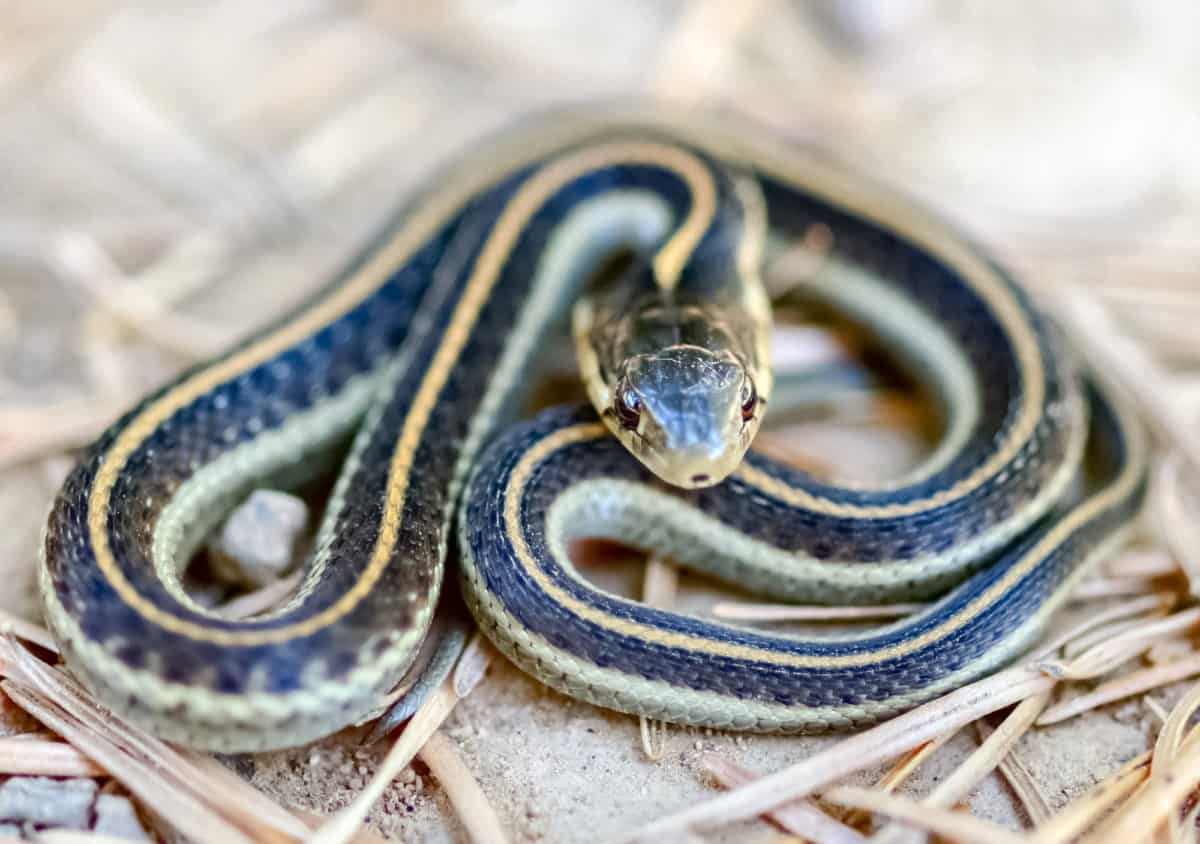California is one of the United State’s most important regions for wildlife. The diverse landscape marries desert, forest, ocean, and mountains, creating a hub of biological diversity.
It’s also the third-largest state by size (excluding Alaska) and encompasses various weather and ecosystems. Snakes are widespread in the Golden State, with approximately 33 different kinds and even more subspecies.
Among California’s most common types of snakes is the Garter snake subspecies. It’s part of the Thamnophis sirtalis family, which is indigenous to North America. There are several types of garter snakes in California, most of which are harmless. Many people keep them as pets.

What You Need to Know About the California Garter Snake
Since there are approximately 35 recognized types of garter snakes in California, they are not always easy to identify. However, although they vary slightly in terms of appearance, size, and habitats, most share certain characteristics. They typically have big round eyes with pronounced pupils, a slender body, keeled scales, and stripes.
Interestingly, it’s believed that these snakes got their name from garter suspenders, which are essentially belt straps clipped to socks to hold them up. The stripes on the snake resemble garter bands, causing people to refer to them colloquially as garter snakes.
However, as the species evolved, several varieties were without stripes or notable markings.
Size
California garter snakes vary in size, usually measuring between 18 and 51 inches in length. The size and weight of the snake depend on the specific subspecies and gender.
Males are usually significantly smaller than females and much lighter. So, if you see a longer, thicker-looking garter, it’s likely a female. Most garter snakes continue growing for their entire lifecycle, which is approximately four years.
Reproduction
Male garter snakes mature enough to mate at around 18 months, while females usually reach reproductive maturity in their second year. Spring marks the beginning of the mating season, just as the snakes come out of hibernation.
Once the females choose their partner and mate, they relocate to their spring-summer habitat and find a suitable location to give birth. Males often stay in the mating area to seek out other partners.
The gestation period usually lasts for around three months. Depending on the subspecies and size of the female, garter snakes can give birth to as few as four and as many as 80 offspring.
Once they are born, garter snakes are left to fend for themselves to survive and source food.

Habitat
Garter snakes are adaptable creatures, demonstrated by their enormous presence throughout North America. You can find garters in all environments, from urban areas to local water sources, from Sierra Nevadas to dense woodlands. However, most subspecies favor moist and grassy habitats, like forests.
Regarding hibernation, garter snakes seek natural cover in burrows, under rocks, or in sheltered tree stumps. Many travel long distances to find a suitable place to rest throughout winter.
Garter Snake Venom
Only a select few garter snakes pack a venomous bite strong enough to affect humans. For the most part, a bite from a common garter snake will leave you with a puncture wound, swelling, and irritation.
The biggest risk is usually an infection of the wound. However, some bite victims may experience an allergic reaction from a bite, which can cause anaphylaxis (shock).
Garter Snake Diet
While they don’t necessarily have venom potent enough to harm humans, garter snakes can most certainly poison smaller animals, like bugs or even mice and frogs. Some people are not phased by having a garter snake in their garden since they help manage the pest population.
Moreover, garter snakes are unlikely to attack humans. Most biting incidents occur when a person provokes or threatens the snake. If you’re worried about a garter snake in your garden, pay attention to its smell. Many of these snakes emit a distinct musk before they attack.

Types of California Garter Snake
There are several sub-species of California garter snakes found scattered throughout the state. Some of the most common types of garter snakes found in California are:
- Western Terrestrial Garter Snake (Poisonous)
- Valley Garter Snake
- San Francisco Garter Snake (garter snake Thamnophis sirtalis tetrataenia)
- California Red-sided Garter Snake
- Coast Garter Snake
- Checkered Garter Snake
- Sierra Garter Snake
- Giant Garter Snake
- Aquatic Garter Snake
Many snakes have a similar appearance, so it can be difficult to distinguish between them. Although most garter snakes are relatively harmless, you should avoid approaching them if they bite. Moreover, you don’t want to mistake a garter snake for a rattlesnake or a breed that could be far more dangerous.
Unless you have experience handling snakes, keep your distance and respect the reptile’s space. If you’re worried about a snake on your property, contact the California Department of Fish and Wildlife to help you deal with the situation.
Garter Snakes FAQs
Are California garter snakes poisonous?
Technically, many garter snakes are poisonous, but their venom doesn’t have the potency to affect humans. They possess a small amount of neurotoxic venom but have difficulty transferring it to humans. Therefore, they aren’t considered dangerous.
How big is a California garter snake?
The most common garter snake in California is the red-sided garter snake. It typically measures around 22 inches in length but can grow up to 39 inches throughout its lifespan.
Can you own a California garter snake?
It’s illegal to take a garter snake from the wild to keep as a pet. Although it’s not recommended, many people own garter snakes. In fact, it’s quite common to breed them.
Are garter snakes harmful?
Garter snakes are not as harmful as other varieties, like copperheads, rattlesnakes, or cottonmouths. Their venom isn’t potent enough to harm humans. While they aren’t aggressive toward people, they may attack if they are provoked and can leave a painful bite.
Are San Francisco garter snakes aggressive?
Despite their intimidating red scales, San Francisco garter snakes are not known to be aggressive. Their mild venom is poisonous enough to kill bugs and small prey, but they possess no fangs and are harmless to humans.
How do San Francisco garter snakes hunt?
San Francisco garter snakes predominantly hunt in aquatic habits, like lakes, ponds, and marshes. They prey mainly on frog species, like California red-legged frogs, juvenile American bullfrogs, and Pacific treefrogs. While they don’t possess fangs, their bite is strong enough to clasp onto their prey, allowing the toxins in their saliva to take effect quickly.
Resources





